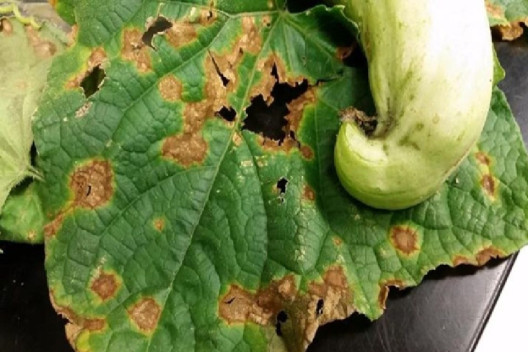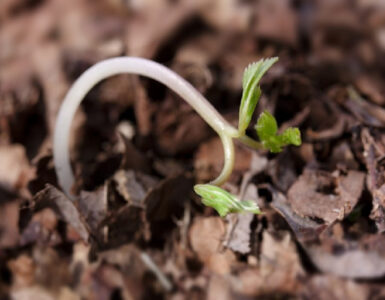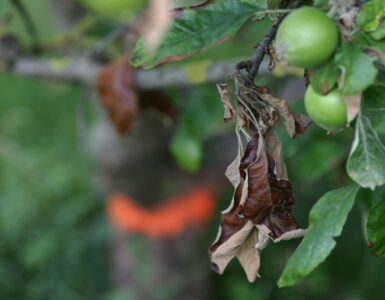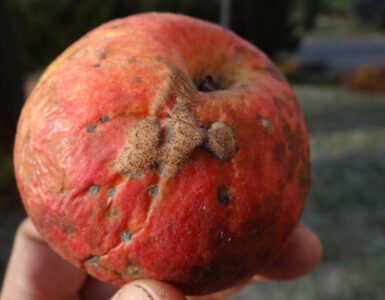You’ve spotted it—lesions of tan or brown discoloration on the leaves of your favorite plant. But what is it?
The answer might be anthracnose, a group of fungal diseases that affect a wide range of plants.
Unfortunately, anthracnose can be challenging to get rid of. But don’t despair! There are many natural ways to control and prevent it.
In this article, I will highlight some natural methods for treating anthracnose. I will cover prevention tips, cultural control measures, and home remedies.
Identification
This fungal disease affects a wide range of plants, including trees, shrubs, and fruit-bearing plants.
Anthracnose causes leaf spots and lesions on plants; they may be tan, brown, or black [1]. Fruits may also show similar spots, which can cause them to become soft and drop prematurely from the plant.
Stems may also exhibit dark lesions that can cause dieback or even the plant’s death if left untreated.
The most common plants affected include oak trees, liriope, cotton, maple trees, ficus trees, roses, mandevilla, sycamore, avocado trees, loropetalum, ash trees, and hydrangeas.
Fruits such as mango, watermelon, and soursop are also likely to be affected. And so are vegetables such as eggplant, chili, beans, and tomatoes.
How to Get Rid of Anthracnose Naturally
It’s essential to act quickly if you suspect anthracnose in your garden. If you suspect your plants have anthracnose disease, try some natural methods first.
1. Remove Infected Plants from the Garden
If you have anthracnose in your garden, you’ll want to remove infected plants from it. This means removing all infected leaves and stems from the plants and disposing of them away from your garden.
If the plant is beyond saving, it’s best to dig it up and discard it. This will reduce the chance of the fungus spreading to other healthy plants nearby.
2. Neem Oil
You can use neem oil safely on vegetable crops because it’s organic and biodegradable. This home remedy is widely used as an organic fungicide to treat a wide range of plant problems.
You can purchase a neem oil all-purpose treatment, such as Neem Max, and apply it to affected plants. Or you can make a DIY anthracnose treatment.
To make a basic homemade spray, combine two tablespoons of neem oil with two tablespoons of liquid soap and 1 gallon of water.
Shake well and apply to plants where the disease is already present.
3. Prune Trees
Pruning is also an effective way to promote healthy plant growth and mitigate the severity of anthracnose. Prune dead or infected branches and limbs.
When you are done with your pruning, it’s a good idea to disinfect your gardening tools to prevent the spread of spores to unaffected parts of your tree.
4. Avoid Overhead Watering
When you water with a sprinkler, you’re creating the perfect environment for the disease to spread. Water droplets from overhead watering can help spread spores between leaves.
Therefore, it’s best to water your plants at the base of the stem and into the soil, where the plant itself can better manage moisture.
Also, be sure to water during the early hours of the day or late in the afternoon so that your plants don’t stay wet overnight.
5. Crop Rotation
Crop rotation is a simple yet effective method for naturally managing anthracnose.
When you plant the same crop in your garden year after year, it will keep the pathogens in the soil alive.
Therefore, rotate with non-host plants. Move host plants far away from the garden.
Crop rotation helps stop harmful diseases like anthracnose. It also offers many other benefits.
This method can also help control pests and weeds, improve soil fertility, and increase yields over time.
6. Mow Grass Regularly and Properly
You probably already know that mowing grass regularly is vital for keeping your lawn looking neat and tidy. But regular and proper mowing can also help control anthracnose.
Mowing with a sharp blade at the correct height for your type of grass helps reduce the spread of anthracnose. Mowing too low may also stress your turf.
Also, only mow the grass when it’s dry. Excess moisture on your lawn can exacerbate problems when mowing.
7. Fertilize Your Grass
Adding fertilizer to your lawn encourages healthy grass growth. This grass can resist diseases and crowd out infected patches when it has the opportunity.
When selecting a fertilizer for your lawn, choose one that is well-balanced for your specific type of soil.
8. BONIDE Liquid Copper Fungicide
This product works wonders in controlling fungal diseases.
Therefore, you can use it as an anthracnose fungicide. It will damage the enzymes and proteins that the fungus needs to thrive.
Takeaway
When it comes to tackling anthracnose, our best bet is to return to basics and use natural remedies to help control it.
Keep a close eye on your plants and take the necessary steps to prevent anthracnose, such as avoiding overcrowded planting beds.
If you do notice any signs of the disease, act quickly by using a copper-based fungicide or a natural remedy to reduce its spread.








Add comment